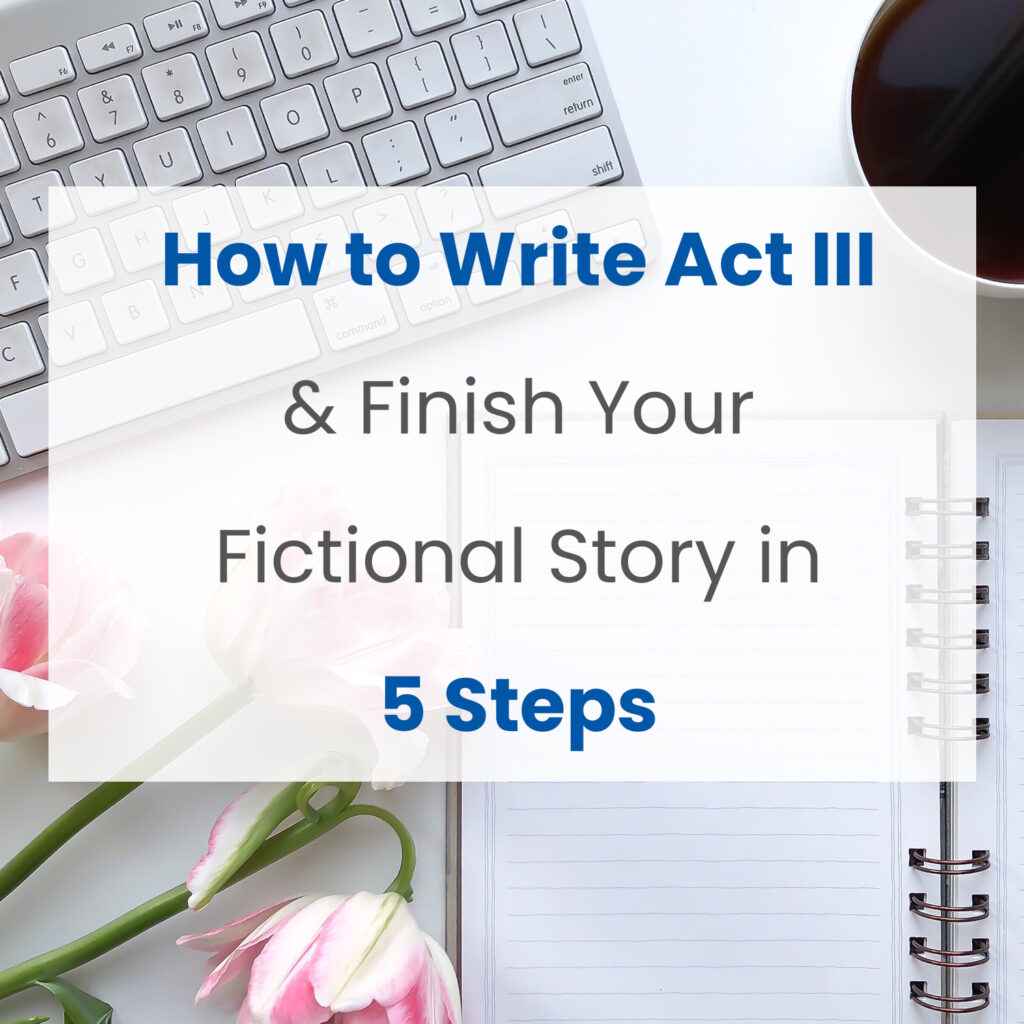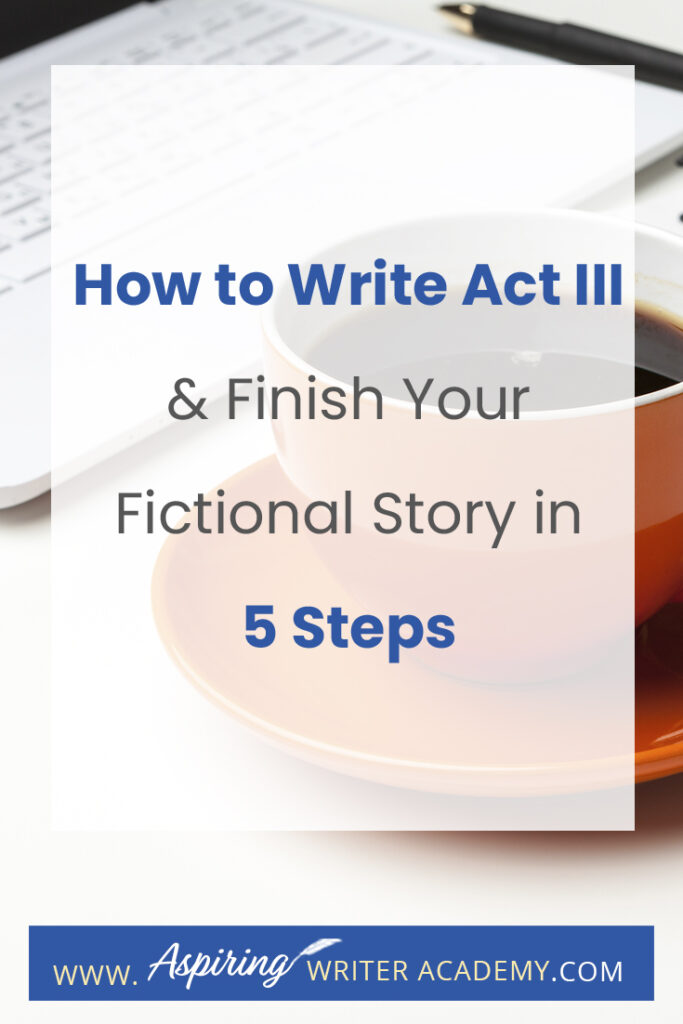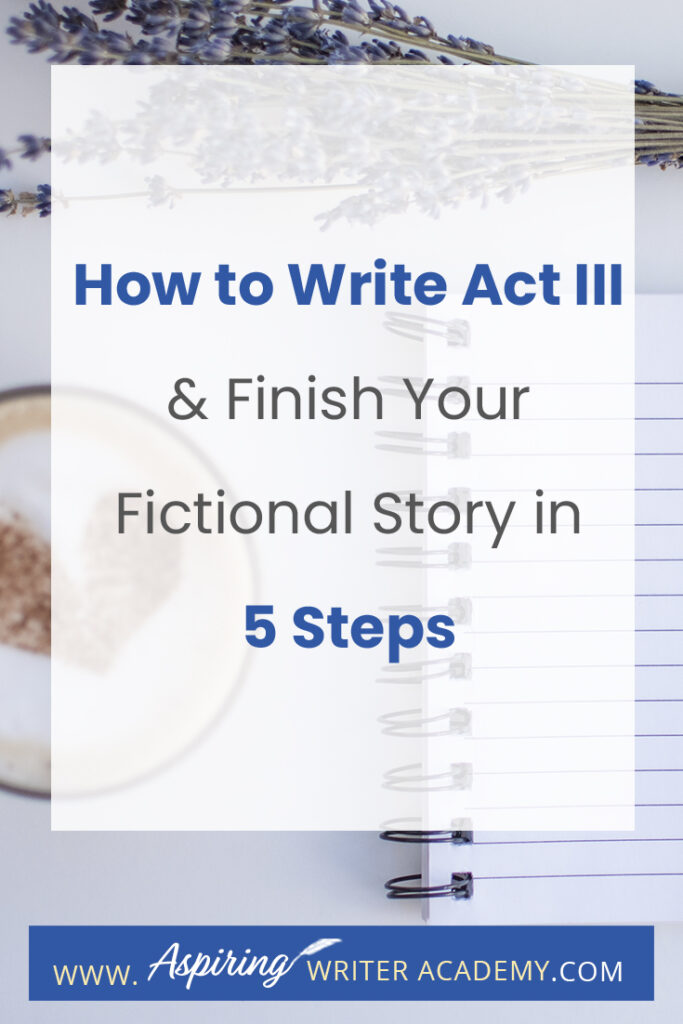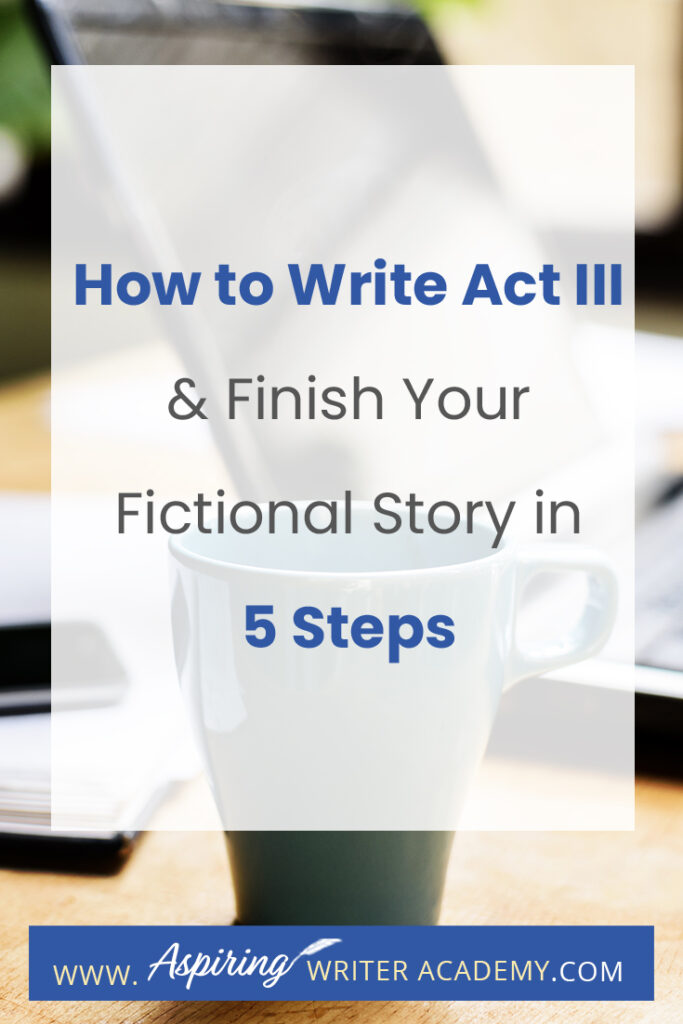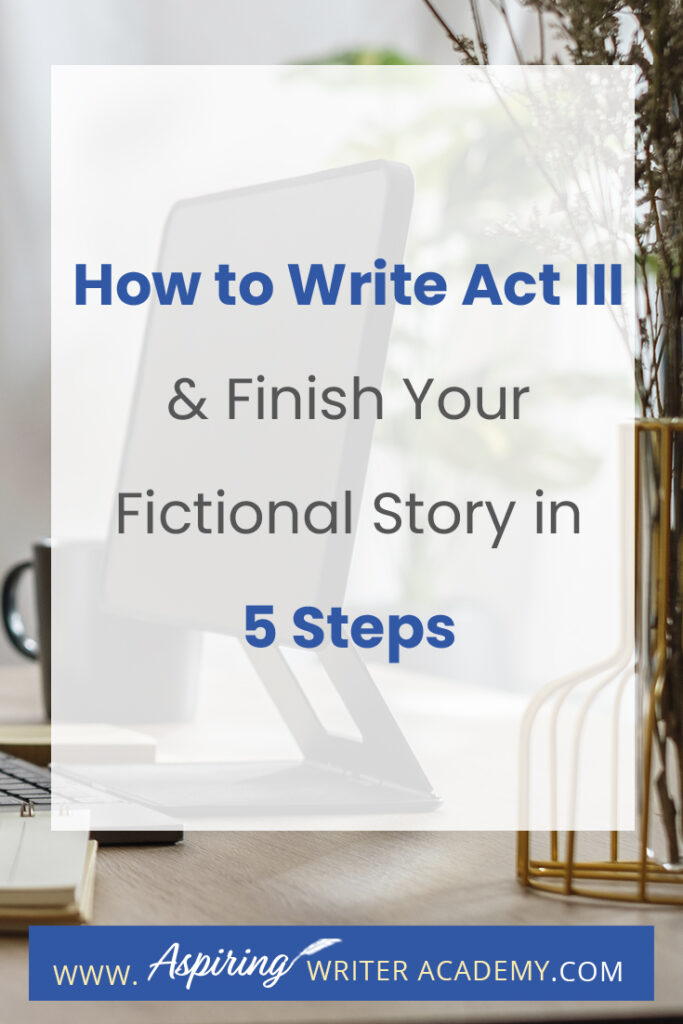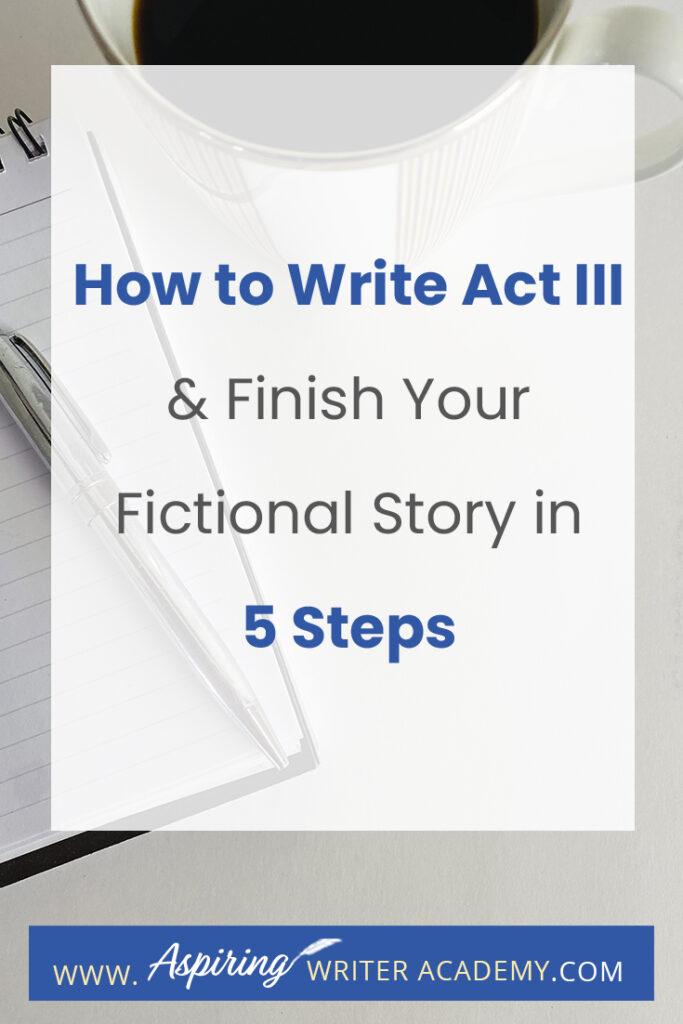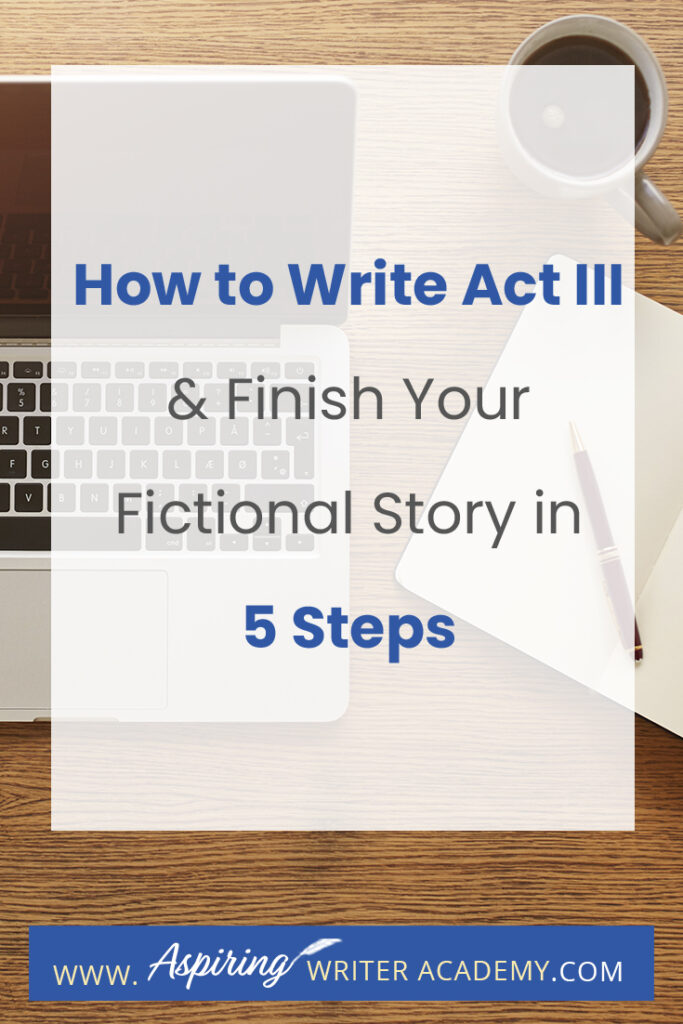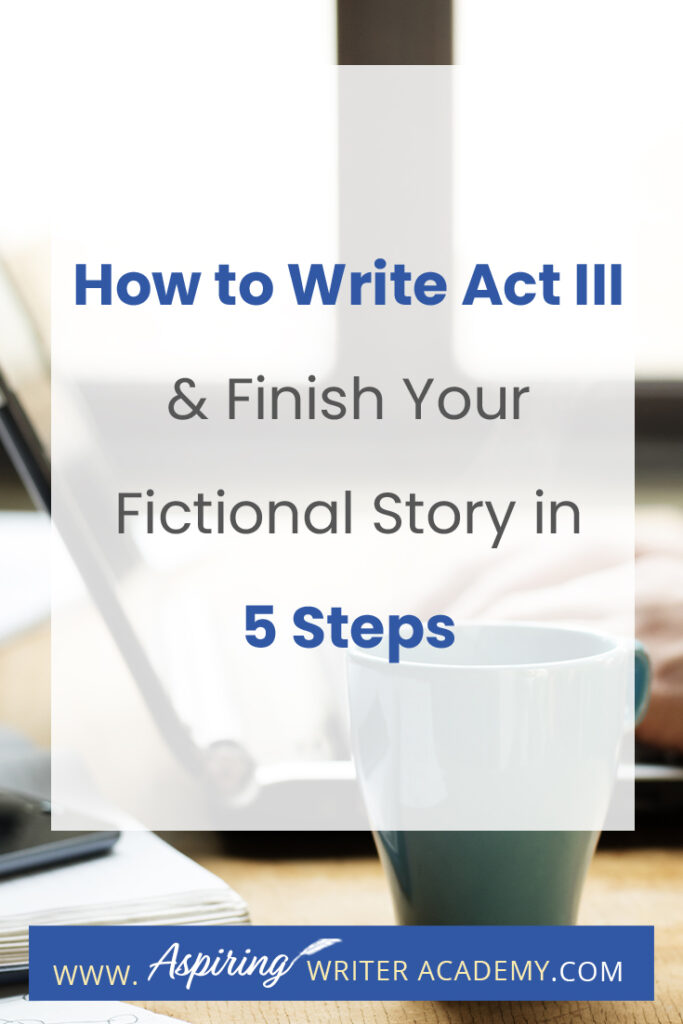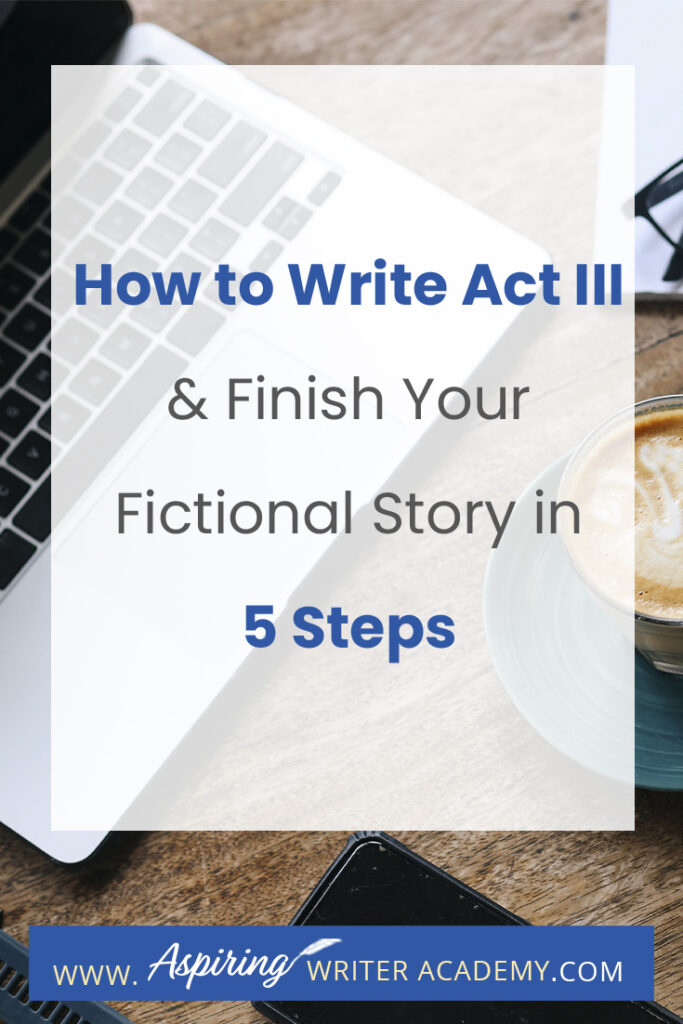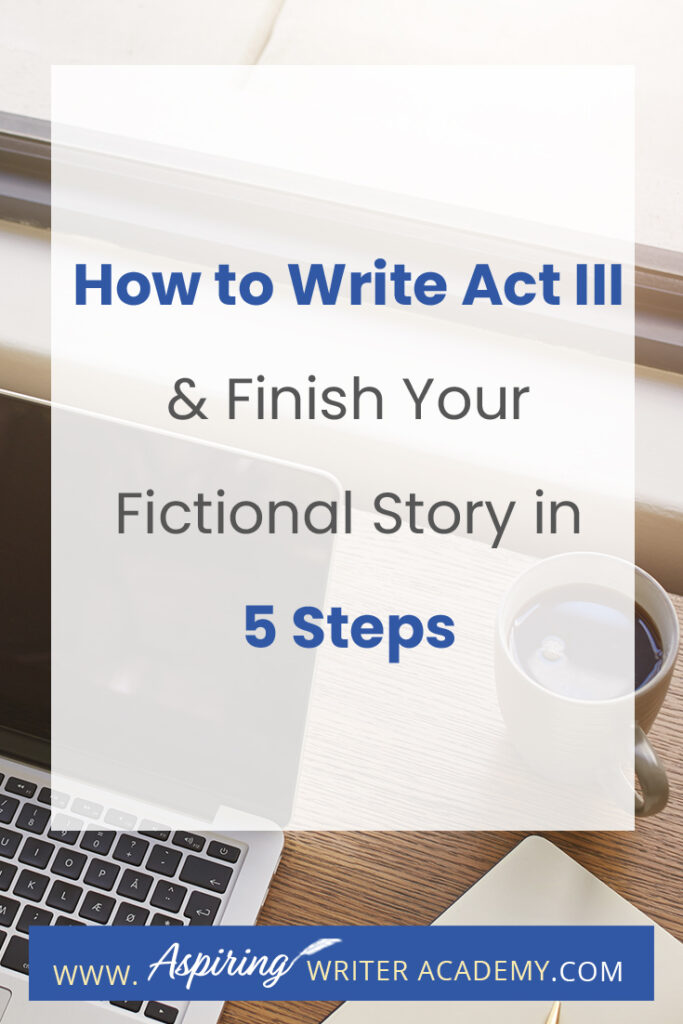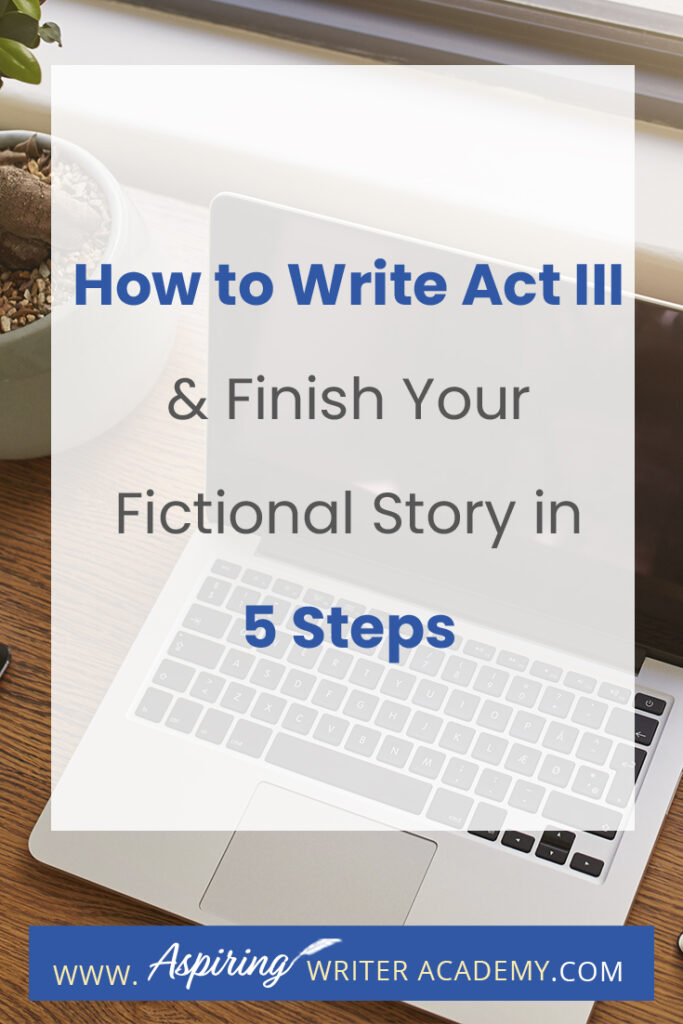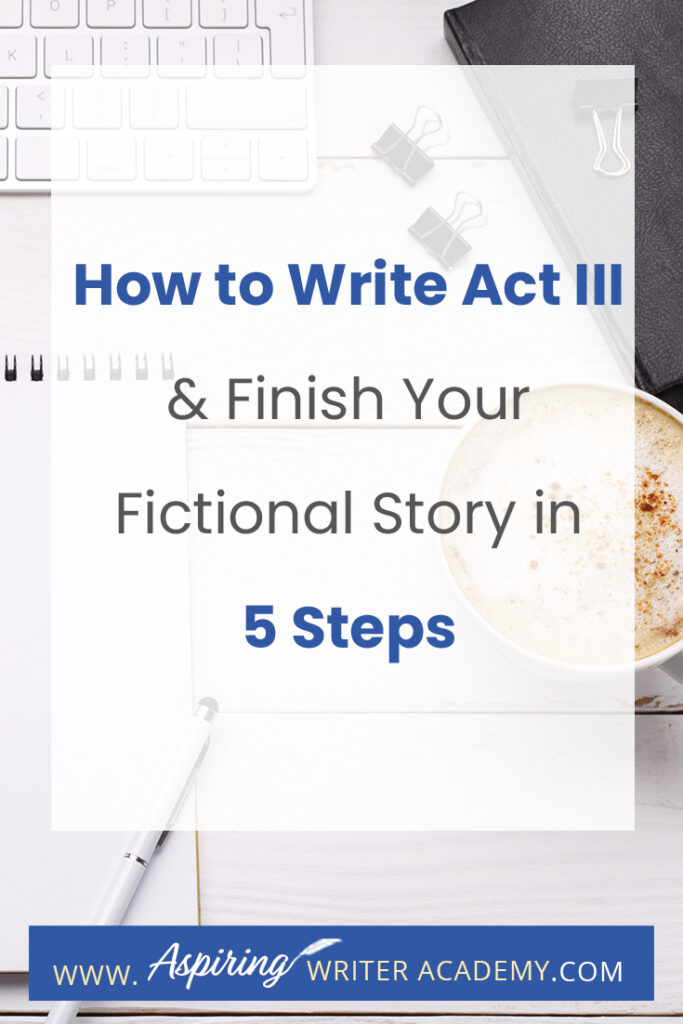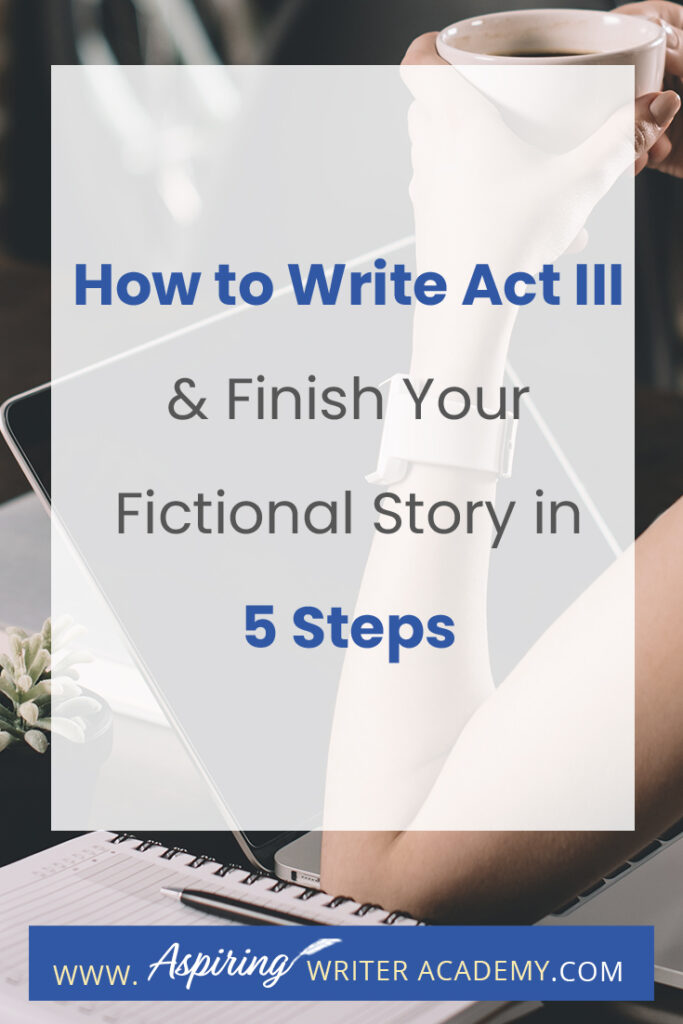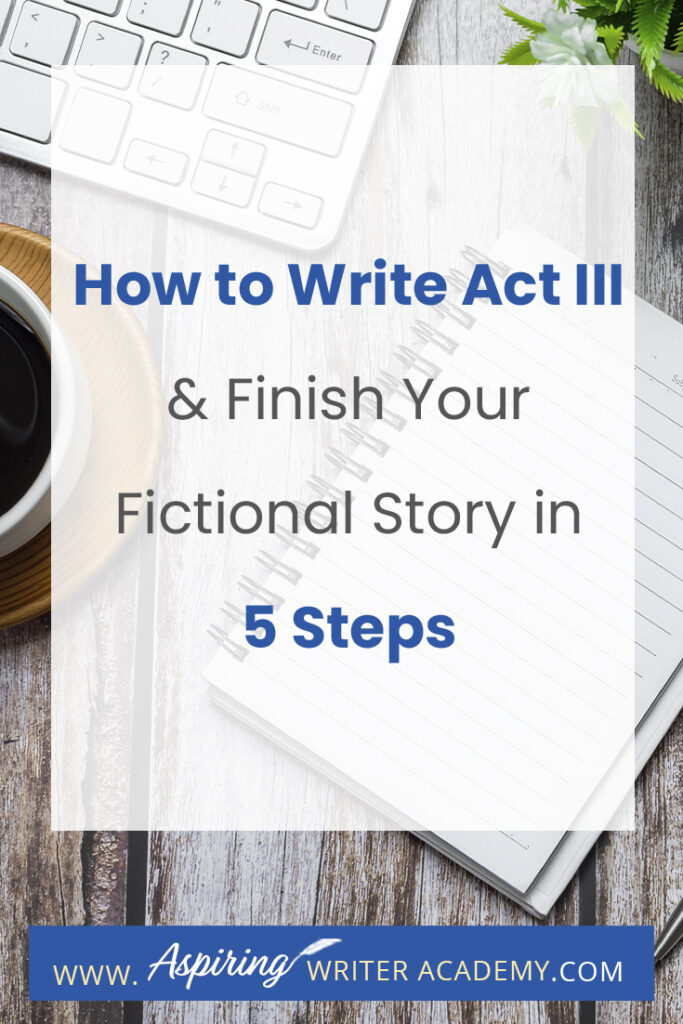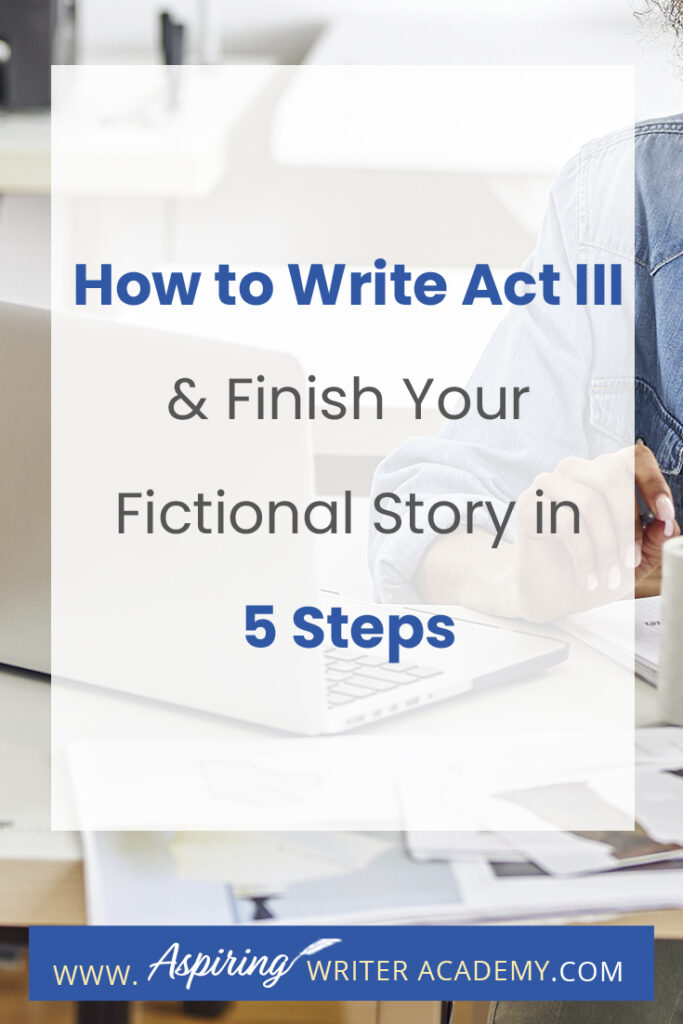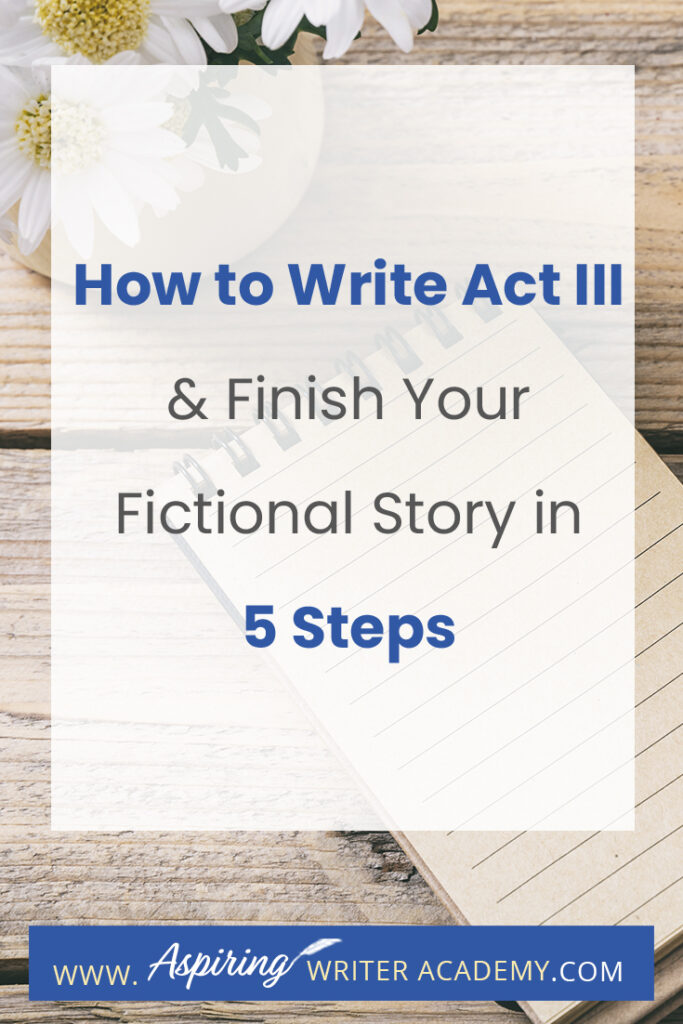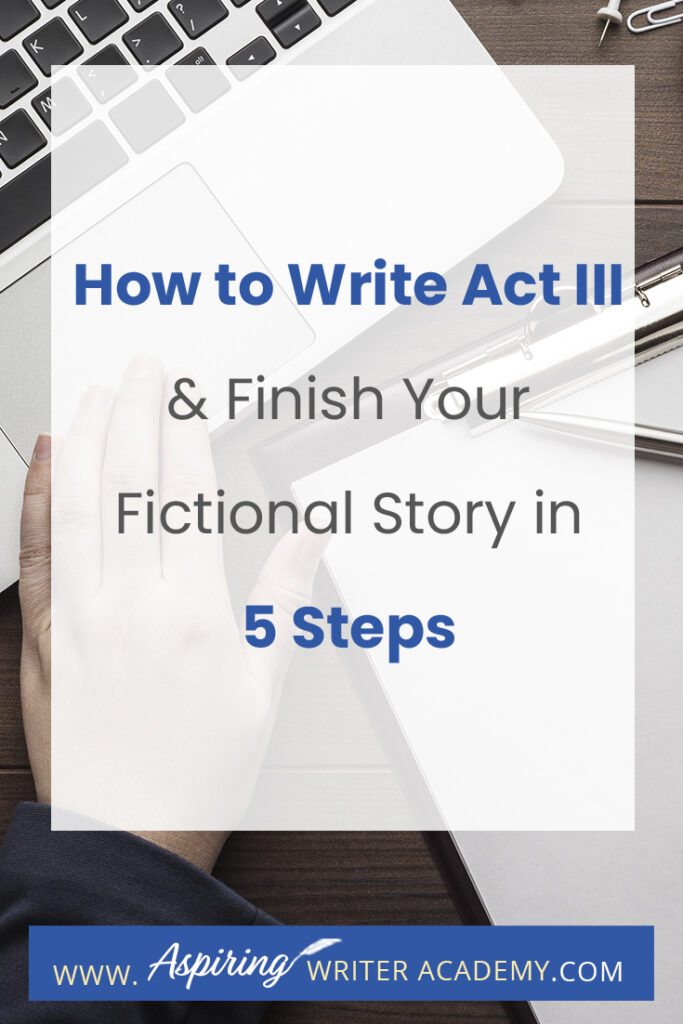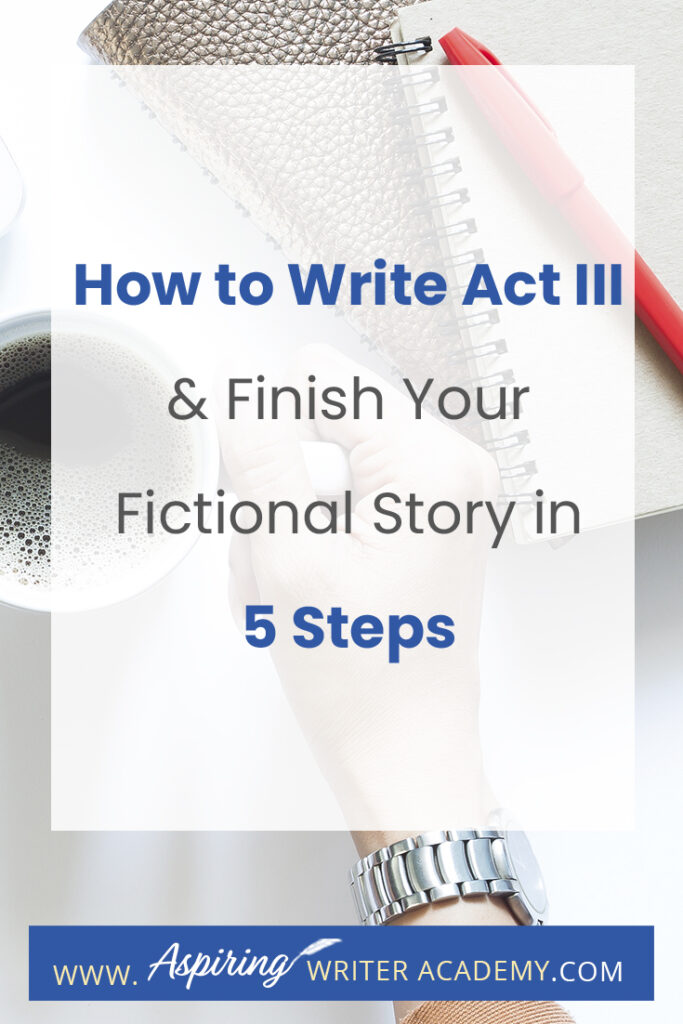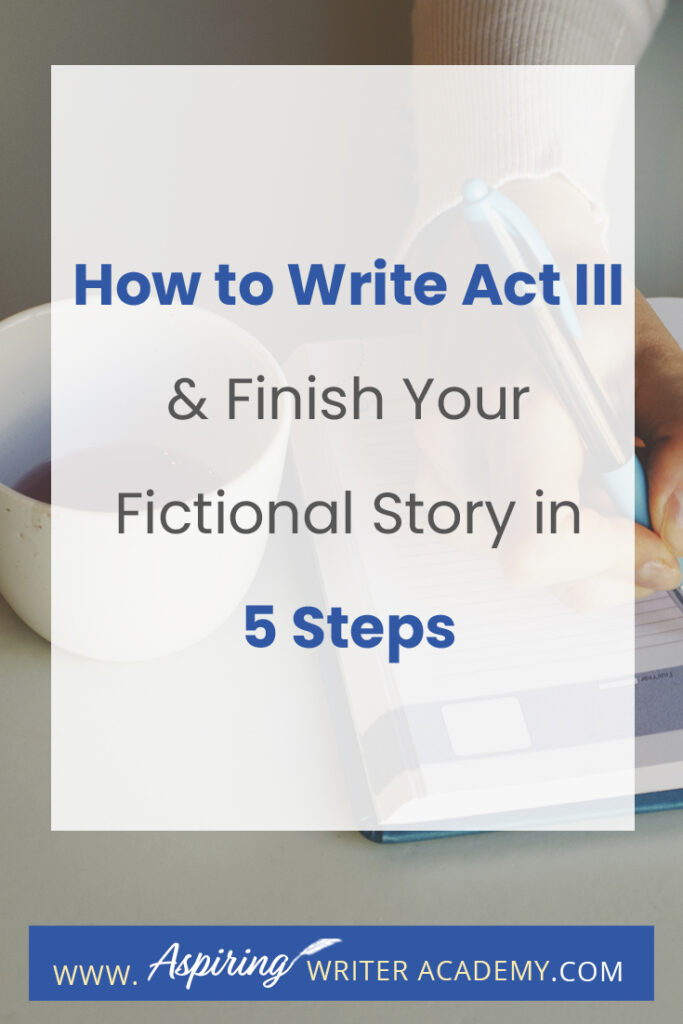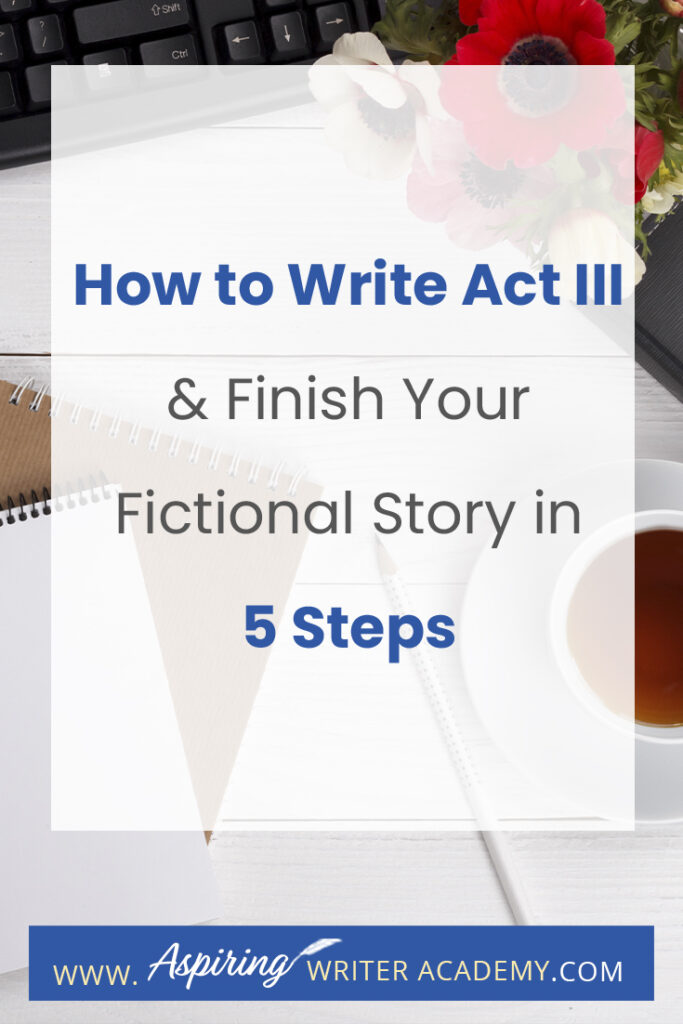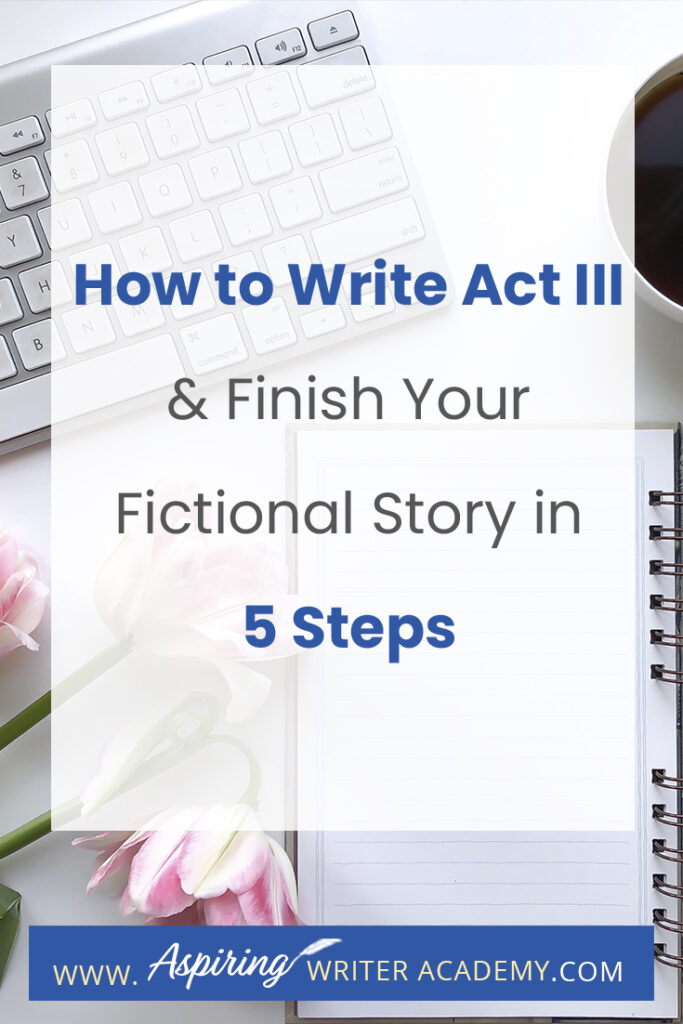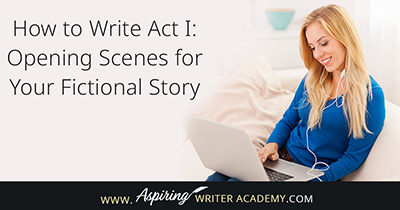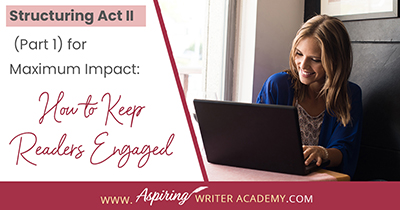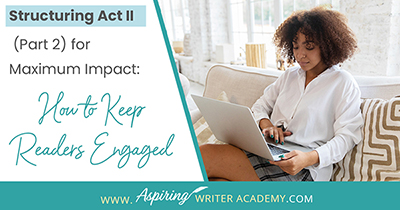How to Write Act III and Finish Your Fictional Story in 5 Steps
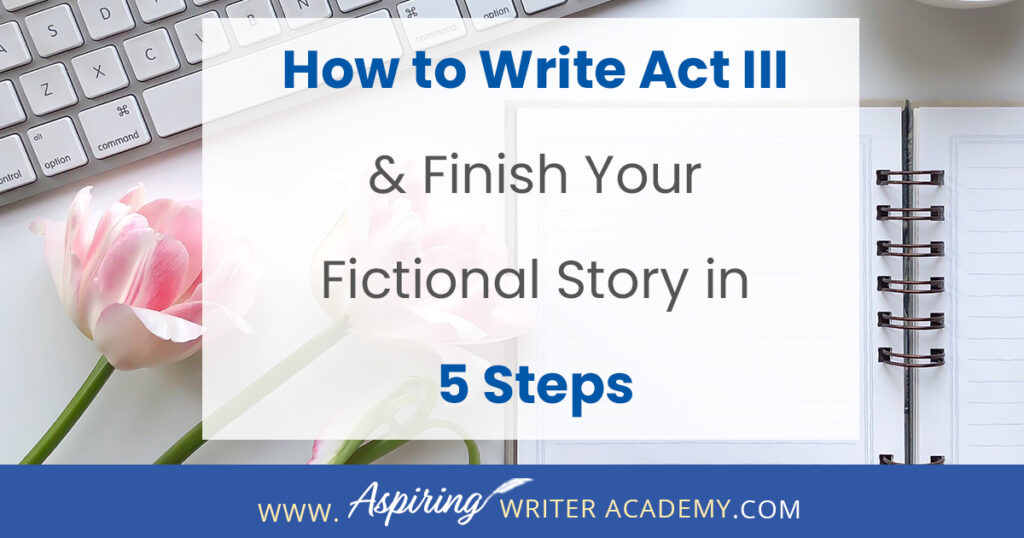
What is included in Act III of a Fictional Novel?
In Act III, new information is revealed, prompting the protagonist to make a decision to regather the team or needed resources in preparation for the climax where there will be a face-to-face confrontation with the opposition, leading to the story resolution.
If you have ever struggled to finish your novel and bring it to a satisfying conclusion, you are not alone. Resolving a story can feel like a monumental feat. The end of a story, the grand finale, is what captivates readers into reading your next book. The pressure to nail down the perfect ending is enormous! Fears may slink into your subconscious asking:
How do I tie up all these story threads, subplots, or loose ends?
Did I write myself into a corner from which I cannot get out?
What if the story doesn’t live up to the reader’s expectations?
Fiction writing doesn’t have to be that hard when you know the 3-Act Structure components that make up a satisfying story. In our post, How to write Act III and Finish Your Fictional Story in 5 Steps, we aim to ease your fears and help simplify the entire process.
Follow along as we take an in-depth look at the following:
- Revelation—New Info Revealed
- Decision & Regathering of the Team, Tools, or Needed Resources
- The Climax—Face-to-Face Confrontation with the Opposition
- Resolution & Wrap-up of Subplots
- Final Capping-off Scene

1) Revelation—New Info Revealed
When using the traditional 3-ACT-Structure model, the protagonist (main character of the story) should have suffered a traumatic blow at the end of ACT II. As a result of the event, the protagonist then separated from friends, family, allies, love interests, or team members (Plot Pt. 2) and finds himself very much alone at the start of ACT III.
The protagonist thinks himself unable to achieve the story goal and believes “all is lost.” He or she may take a moment to reflect and feel despair or sense of hopelessness. The protagonist may convey his despair to another person in dialogue.
Then suddenly, the protagonist receives a new piece of information that changes everything. This info could be discovered by the protagonist himself or delivered by another person, a letter, a call, etc. Does someone come to him with news or reveal a long-hidden secret? Does he receive new insight into a situation?
The protagonist may find out that his friend, ally, or love interest did not betray him after all. Perhaps the protagonist realizes it was his own fears that rose up to haunt him to make him jump to the wrong conclusions or believe the worst. Old faults that the protagonist has been struggling to overcome the entire story have a habit of returning at the Black Moment and with new information the protagonist can come to understand that the down turning event was perhaps his own fault.
Perhaps the protagonist had become too controlling, pushing others away from him. Or maybe someone else had been using or misleading him for a long time and he now sees the truth. His eyes are opened.
Or perhaps the protagonist has been giving it his all to achieve his story goal but thinks the antagonist or villain is just too strong or powerful…until he is told a piece of information which tells him how to defeat this mighty foe. He discovers his opponent’s weakness! The revelation can change the course of a battle and give the protagonist the upper hand, which makes him believe he finally has a chance to “win” if he just tries one last time!
This revelation or new piece of information encourages the protagonist and renews his motivation and his hope that he has a chance to achieve his goal after all. But before he can face the opposition in the final battle (the climax), he has to regroup and regather everything he will need.
2) Decision & Regathering of the Team, Tools, or Needed Resources
With the new information or insight the protagonist received, he or she reflects on everything that has led up to this moment (the past) and then looks forward at what (the future) could look like if he makes one more attempt to achieve his goal. The protagonist now makes a firm decision to face and try to defeat the opposition one last time.
Armed with a new game plan, the protagonist regathers the needed team members that may have scattered. If the separation was the protagonist’s fault, apologies may be needed. If important team members or friends have been kidnapped, perhaps the protagonist needs to go rescue them before he faces the villain at the climax.
Or perhaps the protagonist needs to go collect certain tools, or polish a needed skill, or gather resources to help him gain the advantage at the climax. The protagonist takes the time here to gather whatever he believes he will need to help him win the final battle. Arrangements are made, traps are set, witnesses are gathered, proof is found.
Does he need special weapons? Does he need a certain group of people on his side? Does he need to finish special training?
What will your protagonist need at the Climax to overcome the opposition?
3) The Climax— Face-to-Face Confrontation with the Opposition
The protagonist must face the opposition himself in a face-to-face confrontation. No other character can do this for him. However, other team members and partners can certainly help the protagonist.
Everything has led up to this moment. The Climax should be the most exciting scene or sequence of scenes in your entire book. The reader has spent hours reading your story and wants to savor this moment so do not rush the Climax. Do not wrap up your ending too quickly or too simply or the reader will think— ‘That’s it?’
The Climax should be filled with tension. The protagonist is facing a mighty foe and will either achieve his goal and overcome the opposition, or he will not. Although, if the antagonist is not a true villain and only someone with an opposing view, there may come a pivotal moment at the Climax where a satisfactory compromise may take place. However, this has to be something that could not have been easily achieved at the beginning of the story.
The story events should have changed your protagonist and at this point, he or she can now finally do things he couldn’t do previously. If the protagonist had a habit or faulty way of thinking which acted as his ‘stumbling block’ then over the course of the story, he should have learned to overcome it. Then at the climax, he or she should be able to conquer this bad habit and finally have what it takes to defeat the opposition or make a needed sacrifice to bring about a resolution to the conflict.
How is your story resolved? Did your protagonist need to sacrifice something? Or did the opposition finally have a change of heart or agree on a compromise? Or did the protagonist and his team challenge and defeat the bad guys? Did a mystery sleuth expose a villain for all to see? Did a romantic couple work out their issues so they can have a chance of a happily-ever-after?
There should be several back-and-forth exchanges of action, or dialogue, or both at the Climax to make the moment complex. Nothing should be resolved too easily. Your protagonist has to work for it, to prove himself worthy of overcoming this conflict. Let the protagonist and the opposition fight!
The reader should be sitting on the edge of their seat wondering how this story will be resolved, and who will win.
4) Resolution & Wrap-up of Subplots
The face-to-face confrontation at the Climax resolves the main storyline. How did it end? Did the protagonist win, lose, or resolve the conflict with compromise?
The reader must now be shown what lies ahead for the protagonist. What will his future now look like? What has the achievement of his goal or winning at the Climax done for the protagonist?
If the protagonist overcame a ‘stumbling block’ or faulty way of thinking during the story, then you must show him in a scene acting out that change, so the reader knows it is permanent. Prove the protagonist is changed for the reader.
Example: A man afraid of commitment finally produces a ring (tangible symbolic item representing his change) and proposes to the woman he has come to love.
Or a woman afraid to speak in public, learned to speak up for herself over the course of the story and gained the courage to speak out against the antagonist at the Climax. Now show her speaking at a public rally or accepting a position as spokesperson for a cause she believes in to prove she has truly changed.
Next, wrap-up all loose ends, and resolve subplots. It’s possible that some of the subplots could have been resolved before the climax.
Example: If the protagonist had to make amends with his team members while re-gathering the team and apologize for wrongdoing, then their main issues could already be resolved.
However, the team may celebrate together at this point after the climax to show that they have truly forgiven one another for issues, faults, or misguided actions.
Or the protagonist may need to go find or talk to family members or others at this point to wrap up all storyline ‘threads.’ If you plan to write a sequel, you may choose to let a few subplots go unresolved and present a bit of a mystery or element of intrigue, but the main story plot and most all subplots should be resolved to give the story closure.
Subplot characters are included in the story to either support or hinder the protagonist in his quest to achieve his goal. The result of the Climax should have also affected the subplots to allow them to be resolved.
5) Final Capping-off Scene
Last, we have the final Capping-off scene after the main storyline and all the subplots have been resolved. This is the very last scene of the novel. The Capping-off scene does not have to be long, some are very brief, but make it memorable because it is the image that will stick in your reader’s mind long after they finish the story.
In a romance, the two lovers may have overcome the opposition together or resolved their relationship issues with one another at the Climax or right after the Climax, but it isn’t until the capping-off scene that you show them committing to a happily-ever-after. The Capping-off scene may include a profession of love, a proposal, or if a proposal has already been made, this could be a glimpse of them fulfilling a dream and stepping into their future.
In other stories the protagonist may be shown in the Capping-off scene fulfilling their dream or heart’s desire. If he or she was offered a new job opportunity or new role in society, this last scene may show the character in action taking on that role. What is the benefit or reward your protagonist receives for going on the story journey and succeeding?
In a psychological story, the Capping-off scene may show a scene twist which will keep the reader guessing long afterward—did the protagonist really achieve his goal… or was it all an illusion, a dream, or alternate reality?
In a thriller, the Capping-off scene may show that unbeknownst to the protagonist or other characters in the story, the villain is incredibly somehow still alive, hinting to the reader that there will be a sequel.
Re-Cap of ACT III:
How do you end a fictional novel?
Using the 3-ACT structure model, ACT III contains a REVELATION, where new info is revealed. The protagonist makes a DECISION based on this new knowledge and REGATHERS THE TEAM or NEEDED RESOURCES to prepare for the CLIMAX where there will be a face-to-face confrontation with the antagonist or villain. This is where the protagonist will either achieve the story goal or he will not. Afterward, SUBPLOTS ARE RESOLVED, and the story ends with a satisfying CAPPING-OFF SCENE.

We hope you have enjoyed How to write Act III and Finish Your Fictional Story in 5 Steps and that you have gained some valuable tips to write a satisfying conclusion that will entice readers to keep coming back for more.
If you have any questions or would like to leave a comment below, we would love to hear from you!
If you have missed our previous segments on the 3-Act Structure, you may want to see:
If you like more help developing your story, you may wish to download our Free Brainstorming Your Story Idea Worksheet
Do you find it difficult to create compelling antagonists and villains for your stories? Do your villains feel cartoonish and unbelievable? Do they lack motivation or a specific game plan? Discover the secrets to crafting villains that will stick with your readers long after they finish your story, with our How to Create Antagonists & Villains Workbook.
This 32-page instructional workbook is packed with valuable fill-in-the-blank templates and practical advice to help you create memorable and effective antagonists and villains. Whether you're a seasoned writer or just starting out, this workbook will take your writing to the next level.
Our Goal for Aspiring Writer Academy is to help people learn how to write quality fiction, teach them to publish and promote their work, and to give them the necessary tools to pursue a writing career.

ENTER YOUR EMAIL BELOW
TO GET YOUR FREE
"Brainstorming Your Story Idea Worksheet"
7 easy fill-in-the-blank pages,
+ 2 bonus pages filled with additional story examples.
A valuable tool to develop story plots again and again.
Other Blog Posts You May Like
How to Use Setting to Intensify Your Fictional Scenes
How to Manipulate Pacing to Increase the Intensity of Your Scenes in a Fictional Novel
How to Brainstorm a New Novel Using Goal, Motivation, and Conflict
Fiction Writing: How to Plot a Story where the Antagonist is an ‘Invisible Foe’
Fiction Writing: Create a Storyboard to Map Out Your Scenes
3 Ways to Avoid Writing ‘Episodic’ Scenes in Fiction
How to Write Act I: Opening Scenes for Your Fictional Story
Brainstorming Fiction: What to Do When Your Story Gets “Stuck”
How to Plot Your Fictional Novel (with Free Template Included)
5 Questions to Create Believable Villains
Why Your Characters Need Story-Worthy Goals
How to Captivate Your Readers with Scene-Ending Hooks
Scene & Sequel: The Secret to Plotting an Epic Novel
Scene & Sequel: The Secret to Plotting an Epic Novel (Part 2)

is a multi-published author, speaker, and writing coach. She writes sweet contemporary, inspirational, and historical romance and loves teaching aspiring writers how to write quality fiction. Read her inspiring story of how she published her first book and launched a successful writing career.

